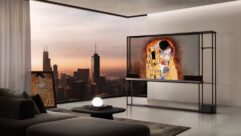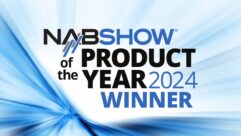

CES ’09: Where the Green Year Began
gadgets and technology demonstrations. But capital investment into new technologies has dwindled as manufacturers try rebates and aggressive price-cutting to stimulate sales. Despite the doom and gloom, demonstrations of energy efficiency were seen in countless booths, ranging from new LCD and plasma TV designs to low-power projections systems.
Credit: Pete Putman, CTS
The annual Consumer Electronics Show, one of the largest trade shows in the world, is notable for its “gee-whiz” gadgets and technology demonstrations. And while some of those products will never see the light of day, others are destined to become an integral part of our lives. As you’ve probably heard by now, attendance at this year’s show was definitely impacted by the recession, which has left no sector of the electronics industry unscathed. Capital investment into new technologies has dwindled as manufacturers try rebates and aggressive price-cutting to stimulate sales. HDTV sales numbers in particular took a big hit in the fourth quarter of 2008, normally a big selling season. LCD and plasma panel shipments also declined in Q4 2008, a trend that is expected to continue well into 2009 despite the pending digital TV transition and continued downward pricing pressure.
Energy Stars
Despite the doom and gloom, there were a few consistent themes at CES ’09, and one of them was “going green.” Demonstrations of energy efficiency were seen in countless booths, ranging from new LCD and plasma TV designs to low-power projections systems. Small, plug-in power consumption meters with built-in LCD displays of volts, amperes, and watts were hot items in all the halls. (In fact, the power meters themselves often brought more pricing and availability inquiries than the TVs they were connected to!)
To see how widespread this trend had become, you needed look no farther than Mitsubishi’s oft-delayed 65-inch LaserVue DLP rear-projection TV. A year ago, LaserVue had a splashy debut party at the Palm Casino. Twelve months later, it made a low-key appearance at the Digital Experience tabletop show, and the focus of Mitsubishi’s demo was more on LaserVue’s low power consumption (about 95 to 110 watts most of the time) than its underlying imaging technology.
Even Greenpeace held a press conference at the show, touting the green performance of numerous CE gadgets that ranged from computers to GPS navigation units, cell phones, and HDTVs. So many manufacturers are now claiming Energy Star compliance that there are increasing calls to raise Energy Star standards, lest it become meaningless.
Does power consumption really matter to your clients? I’m willing to bet it does, particularly when you consider that in some states (including my home state of Pennsylvania), rate caps are being lifted next year as part of ongoing deregulation of the electric power industry. In some parts of Pennsylvania, electric bills could go up by as much as 20 percent a month–ouch.
Power consumption data may not currently be part of writing a proposal or submitting a bid, but it probably will be in less than a decade. Consider that at the show, Panasonic exhibited its new Neo line of plasma monitors featuring 30 percent less power consumption; Samsung and LG Display showcased new LED-powered backlights for LCD monitors; Vivitek demonstrated a production model home theater projector with an LED illumination source; and LG Display also spotlighted production-ready 15-inch OLED displays. These are all evolving display technologies that are tied to “going green.”
LEDs are not only logical candidates to replace cold-cathode fluorescent lamps (CCFLs) that contain salts of mercury, they’re also being tested as replacements for short-arc projection lamps (which also contain mercury). Being green isn’t just about energy savings. It’s also about removing hazardous substances from the environment, and mercury is a huge offender.
Beyond Green
Granted, not everything that happened at CES was green. I’d be remiss if I didn’t point out the other main display trend we’ll be dealing with soon. Aside from power consumption and environmental issues, there was a notable emphasis on media distribution and connectivity. The next Next Big Thing is streaming video, as evidenced by a new line of HDTVs from LG with Ethernet connections for Netflix downloads. Samsung and LG also showed Blu-ray players with Netflix connectivity, which allows downloading of SD and HD TV shows and movies.
Similar interfaces were also on display in the Sony, Hitachi, Toshiba, Panasonic, and Samsung booths. (JVC also showed broadband Internet connectivity at its Caesars Palace showroom.) You can thank
YouTube and IPTV download services, such as Netflix and Amazon’s UnBox service, for this sudden explosion of interest in IP-based media delivery platforms–old hat to those working in digital signage markets, but a new twist on conference room and classroom installations.
In a recent survey conducted by Oregan Networks and Micronas, 71 percent of people who expected to buy a new HD set in the next two years wanted that set to include a factory-installed media browser, because “it would offer them more entertainment choices,” the survey said. In fact, accessing video on demand (VOD) without the use of a computer ranked as the most important use of an integrated media browser.
It should be clear by now that the consumer AV marketplace–long thought of as the “tail” by manufacturers–is actually wagging the dog, or the professional marketplace. What that means is that more and more integrated HDTVs–and even some professional monitors–are likely to include a standard Ethernet interface, and perhaps some on-board RAM or hard drive storage. What an installer would do with that capability is up to them, but it will certainly go well beyond the remote operation and diagnostics functions that most customers use for connected projectors and flat-panel displays.
Green, streaming display technologies: Don’t be surprised to see these same trends–in various degrees of advancement and pro-specific application–at June’s InfoComm ’09 in Orlando, Fla. There will probably be a few new wrinkles as well.
InfoComm Educator of the Year Pete Putman is a Pro AV contributing editor and president of ROAM Consulting in Doylestown, Pa.










